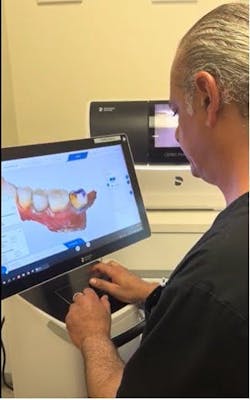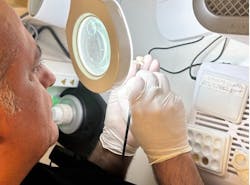Evaluating in-office milling technology: Key considerations for dental practices
Dental professionals are constantly seeking ways to enhance patient care, improve efficiency, and stay at the forefront of technological advancements. One such innovation that has garnered significant attention is in-office milling technology, designed for same-day restorations, which enables dentists to streamline their workflow and offer patients a more convenient experience.
However, before investing in this cutting-edge equipment, it’s crucial to consider several factors to ensure it aligns with your practice’s goals and capabilities. Here I’ll share my insights and experiences to help guide you through the essential aspects of purchasing and implementing in-office milling technology in your practice.
Many of the benefits of this technology are well-known within the dental community, and there is undoubtedly a place for this innovation in modern dental practices. The advantages it offers can significantly enhance both patient care and practice operations. One of the biggest considerations is the return on investment (ROI). The factors that should be considered are the reduction in laboratory fees, elimination of the need to temporize, and elimination of impression material. These can result in substantial cost savings. The following are some of the key benefits to consider:
Time efficiency: The most significant advantage of in-office milling technology is the ability to complete restorations in one visit. Traditional methods require multiple appointments and the use of temporary crowns, which can be inconvenient for patients. With in-office milling, the entire process—from digital impression to final placement—can be done in about an hour.
Patient experience: Patients appreciate the time savings and convenience of same-day restorations. In addition, in-office milling reduces discomfort and eliminates the inconvenience of temporary crowns falling off or needing adjustment.
Practice efficiency: By reducing the number of appointments and streamlining the restoration process, in-office milling can significantly enhance practice efficiency. This allows dentists to see more patients and potentially increase revenue.
Patient perception: Having advanced technology in your practice can positively influence patients’ perceptions, showcasing your commitment to providing the best possible care with the latest advancements.
Marketing opportunity: With the right marketing message, this technology can help attract new patients who see the benefit of receiving their crowns in one visit.
These financial benefits, combined with improved patient satisfaction and practice efficiency, make in-office milling a worthwhile investment for many dental practices.
Prepurchase considerations
However, before investing in this technology, it’s important to consider several factors to ensure that it aligns with your clinical and business goals. One critical consideration is quality of patient care. Taking on the role of creating the restorations and ensuring that the quality meets or exceeds that of traditional laboratory-fabricated restorations is crucial. To do this, the office will need to understand the learning curve that technology presents (figure 1).
The first step is to evaluate how much time you want to be directly involved in the restorative process. Typically, it’s essential for both the dentist and a key member of the team to undergo thorough training to ensure proficiency with the system. While the learning curve can vary, it does require a significant time investment initially, with intensive training and committed practice. While some dentists prefer the technical aspects of digital dentistry and want to perform in-office milling procedures themselves, many prefer to focus on patient care and delegate the technical tasks to a team member or a new hire (figure 2).
Next, it’s important to assess the space requirements to accommodate the equipment in the practice. The system typically includes several components, including a milling unit, a scanner, and a computer. The milling unit, which is often the largest component, requires a dedicated, stable surface and adequate ventilation to function properly.
Additionally, the practice needs to allocate space for the scanner and computer workstation. The scanner should be easily accessible in the treatment rooms to facilitate a seamless workflow, while the computer workstation should be positioned to allow the dental team to efficiently design and monitor the production of the restorations. Careful consideration with regard to the space requirements is crucial to ensure a smooth integration.
Another consideration is your practice volume. For low-volume practices, investing in in-office milling technology may not yield an adequate ROI due to the significant initial costs and ongoing expenses. These systems, including the milling unit, scanner, and associated software, can cost $100,000 to $150,000. Practices with a lower volume of restorative procedures may find it challenging to recoup these costs within a reasonable timeframe.
The financial benefits of reduced lab fees and increased efficiency are only realized when the technology is fully implemented and used frequently. It is therefore important to do a proper analysis to determine if the practice has the volume to offset the high initial investment and the maintenance cost. This can be done by conducting a cost-benefit analysis or investment appraisal.
This involves evaluating the potential benefits of the new equipment against the costs incurred in acquiring, implementing, and maintaining it. The goal is to determine if the investment will yield a positive return and contribute to the overall profitability and efficiency of the business. This analysis typically considers factors such as the initial purchase cost, operational savings, increased revenue, improved efficiency, and the time required to achieve a return on the investment.
Creating a practice that is technology-dependent requires a contingency plan for any technical issues or malfunctions that could disrupt the workflow and, ultimately, patient care. It’s critical to understand the service agreement to ensure prompt technical support and regular maintenance. There needs to be dedicated staff that can deal with common issues and ensure that basic maintenance is performed.
Additionally, having a backup solution, such as agreements with local labs for emergency cases, can prevent service interruptions. If you’re completely offline, this may mean that traditional impression methods will need to be performed as well as maintaining temporary restoration supplies. By proactively preparing for potential breakdowns, practices can reduce the impact on their workflow and maintain a high standard of patient care, even during technical difficulties.
Conclusion
While in-office milling technology offers numerous benefits, such as improved efficiency, enhanced patient satisfaction, and reduced operational costs, it’s essential for dental practices to thoroughly evaluate their specific needs and capabilities before making the investment. High-volume practices are likely to see a significant ROI, whereas low-volume practices may struggle to justify the costs.
Key considerations include the initial and ongoing expenses, space requirements, the learning curve for dentist and staff, and the need for a robust contingency plan to manage potential equipment breakdowns. By conducting a comprehensive cost-benefit analysis and preparing for the operational challenges associated with new technology, dental practices can make informed decisions that align with their long-term goals and ensure the successful integration of in-office milling into their workflow.
About the Author

Shahin Issac Bina, DDS
Shahin Issac Bina, DDS, graduated from dental school in Stony Brook, New York, in 1994. With advanced training through a general practice residency at New York Hospital, affiliated with Cornell University, Dr. Bina has more than 25 years of experience in Southern California. He founded the Bina Dental Institute, offering continuing education in dental surgery and implants. Contact Dr. Bina at [email protected] or (818) 907-1818.




